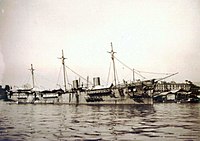Evolutions Squadron
| Evolution Squadron | |
|---|---|
| Esquadra de Evoluções | |
| Active | 19 August 1884 – 1886 |
| Country | |
| Branch | |
| Type | naval squadron |
| Garrison/HQ | Neutral Municipality |
| Commanders | |
| Notable commanders | Artur Silveira da Mota |
The Evolution Squadron was a naval squadron of the Brazilian Imperial Fleet composed of the best ships of its time in several characteristics. It was created in 1884 with the purpose of developing new naval tactics inspired by the Austria tactics in the Battle of Lissa where its naval force faced and defeated the much superior Italian fleet.
History
Origins


After the end of the Paraguayan War, Brazil was concerned with repairing the damage caused to its vessels, refitting them and transforming the Armada into the fourth most powerful navy in the world.[1] From 1870, with the possibility of a conflict with Argentina, the Brazilian Empire aimed to further strengthen its Armada. In 1873 it acquired a gunboat and a corvette; a battleship and a monitor in 1874 and soon after two cruisers and another monitor.[2][3]

In the 1880s, the navy continued its program of strengthening it, with several Brazilian arsenals building dozens of warships.[4] Four torpedo boats were purchased, the Escola Prática de Torpedos was created for enlisted men, and a workshop for the manufacture and repair of torpedoes and electrical appliances was set up at the Arsenal of the Navy in Rio de Janeiro on November 30, 1883.[5]
However, the apex of the Imperial Navy occurred with the incorporation of the ocean-going battleships Riachuelo and Aquidabã (both equipped with torpedo launchers) in 1884 and 1885, respectively. Obtaining these ships enabled Brazil to remain “among the naval powers of the universe”.[6]
Squadron
The High Command of the Imperial Navy studied the possibility of putting into practice the tactics employed by the Austrians at the Battle of Lissa in 1866. Even though they were outnumbered (seven battleships and 20 wooden ships with 532 cannons) they managed to impose a defeat on the Italian naval forces (twelve battleships and nineteen wooden ships with 641 cannons).[7] Such tactics demonstrated the domination of the seas by the armored fleets, grouped in squadrons composed of units with a high degree of efficiency in communications and maneuver.
Ships


From 1884 to 1886, the Esquadra de Evolções was composed of:
| Battleships | |
|---|---|
| Riachuelo (Flagship) Sete de Setembro Solimões Javary | |
| Cruisers | |
| Guanabara Almirante Barroso Trajano Primeiro de Março | |
| Torpedo class No. 1 | Torpedo Alfa class |
| No. 1 No. 2 No. 3 No. 4 |
Alfa Beta Gama |
See also
References
Citations
- ^ Janotti 1986, p. 66
- ^ de Holanda 1974, p. 272
- ^ Doratio 2002, p. 466
- ^ Maia 1975, p. 225
- ^ Maia 1975, p. 221
- ^ Maia 1975, p. 227
- ^ Scotti 2004, p. 1
Bibliography
- Janotti, Maria (1986). Os Subversivos da República. São Paulo: Brasiliense. p. 66.
- de Holanda, Sérgio Buarque (1974). História Geral da Civilização Brasileira: Declínio e Queda do Império. São Paulo: Difusão Européia do Livro. p. 272.
- Doratio, Francisco (2002). Maldita guerra: nova história da Guerra do Paraguai. São Paulo: Companhia das Letras. p. 272. ISBN 85-359-0224-4.
- Maia (1975). A Marinha de Guerra do Brasil na Colônia e no Império. Rio de Janeiro: Cátedra.
- Alsina Jr, João Paulo (2015). Rio-Branco: grande estratégia e o poder naval. Rio de Janeiro: FGV Editora. ISBN 9788522516827.
- Scotti, Giacomo (2004). Lissa, 1866 : la grande battaglia per l'Adriatico. Trieste: LNIT. ISBN 8881902117.
